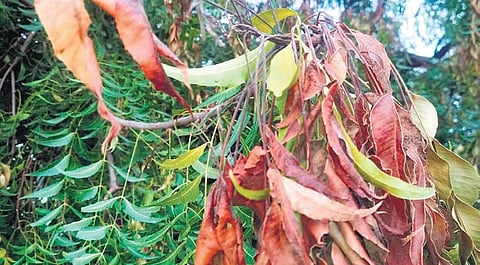

HYDERABAD: The neem tree is known for its various medicinal benefits but climate change has not left this ‘miracle’ tree untouched. It is famed for its anti-malarial, anti-fungal, antiviral and anti-carcinogenic properties. However, in recent times, a strange phenomenon has been witnessed in neem trees across Telangana and Andhra Pradesh.
The ‘Tea mosquito bug’, usually found in tea plantations, is infecting soft tissues at the tip of the branches of neem trees, leading to degeneration and in some cases, makes the tree’s foliage appear lifeless. Dr M Padmaiah, a retired principal scientist (IIOR-ICAR), observes that the infestation has become more rampant due to climate change.
The Tea mosquito bugs, which have a life cycle of 25-32 days, are also found in plants like cashew, cocoa, jamun, grapevine, tamarind, henna, black pepper, cotton, red gram, cinnamon and some other species.The mother insects lay around 50 eggs each in the soft tissues of stem shoots during February and March by puncturing them. Out of these, 60 per cent survive and undergo development as nymphs in five phases for 13-15 days before becoming bugs.
When tender shoots start emerging from branches, the bugs and nymphs feed by sucking the sap from the tree. As they feed, they release poisonous oral secretions which kill the tissues. “When they puncture the tissues, a gum oozes out of the holes and when it rains, Phytopthora, soil-inhabiting pathogens, which may cause degeneration of the entire branch, causing Dieback disease in the trees,” says Dr Padmaiah.
He, however, maintains that the tree dying from either the bug attack or the disease is not a thing to worry about as neem trees are deciduous. They have a strong bark and deep root system and have a great ability to regenerate. Further studies are needed to ascertain how the bugs have been able to evade the insect-repellent Azadirachtin, the chemical compound found in almost all parts of the neem tree.
Fighting the enemy
To mitigate the infection, Dr Padmaiah suggests developing and placing pheromone traps specifically made to capture Tea mosquito bugs and suggests spraying profenofos (2 ml per litre water) and acetamide (0.6 gm per litre of water) in the area infected by the bugs and nymphs - in February and March. when they make the tree their host. Dr Padmaiah opines that encouraging natural parasites (good ones) to thrive could help mitigate the bug infestation, as controlling it mechanically or manually is difficult